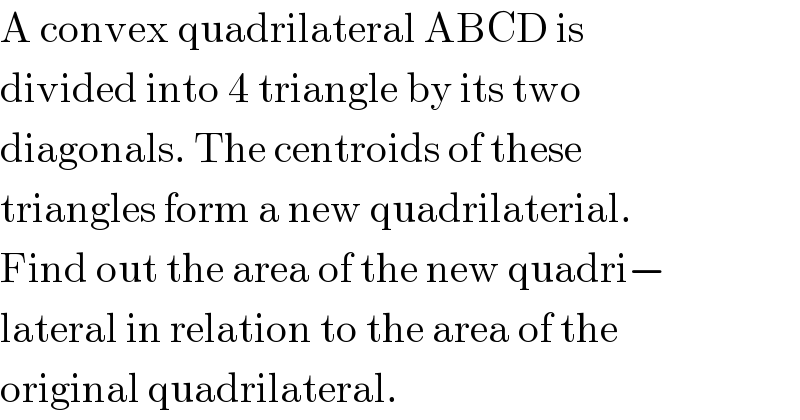
Question and Answers Forum
Question Number 15904 by mrW1 last updated on 15/Jun/17

Commented by mrW1 last updated on 15/Jun/17

Answered by ajfour last updated on 15/Jun/17
![let AO=a, BO=b, CO=c, DO=d and α=∠AOB, ∠BOC=π−α ∠COD=α , ∠DOA=π−α Area_(ABCD) =(1/2)[absin α+ bcsin (π−α)+cdsin α+dasin (π−α)] Area_(ABCD) =(1/2)(sin α)(ab+bc+cd+da) ⇒Area_(ABCD) = (1/2)(a+c)(b+d)sin α ΔAOB and ΔCOB have the same height (with their bases along AC ) = bsin α and their centroids are E and F respectively with height = (b/3)sin α. so EF is parallel to AC. similarly EH , FG // BD. we can conclude EFGH is a parallelogram. let its base be along AC of length =(1/3)(a+c) its height ⊥ to AC =(1/3)(b+d)sin α Area_(EFGH) =(1/9)(a+c)(b+d)sin α = (2/9)×(1/2)(a+c)(b+d)sin α Area_(EFGH) =(2/9)(Area_(ABCD) ) .](Q15913.png)
Commented by mrW1 last updated on 15/Jun/17

Commented by ajfour last updated on 15/Jun/17

Answered by mrW1 last updated on 15/Jun/17

Commented by mrW1 last updated on 15/Jun/17

Commented by ajfour last updated on 15/Jun/17

